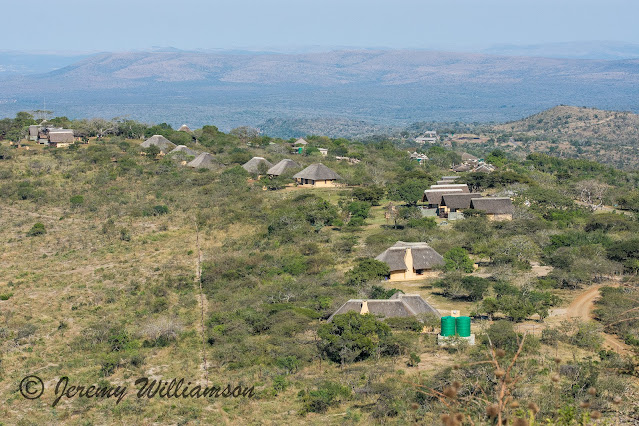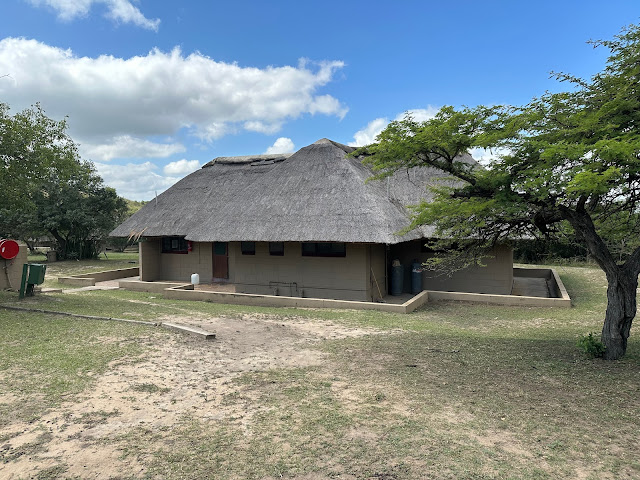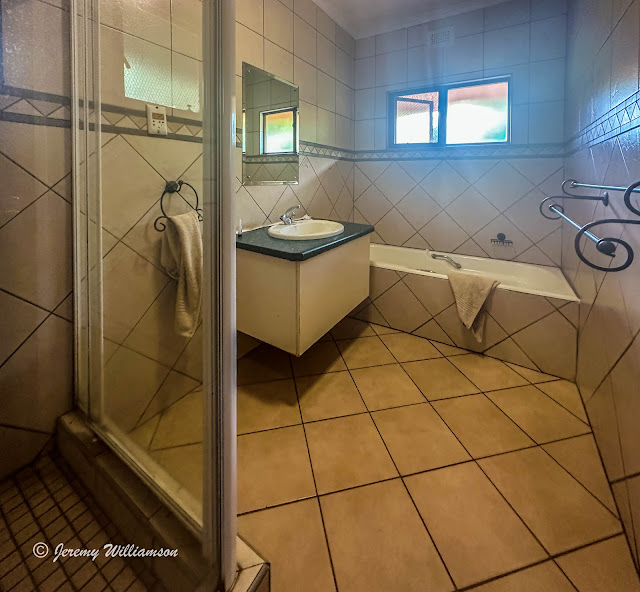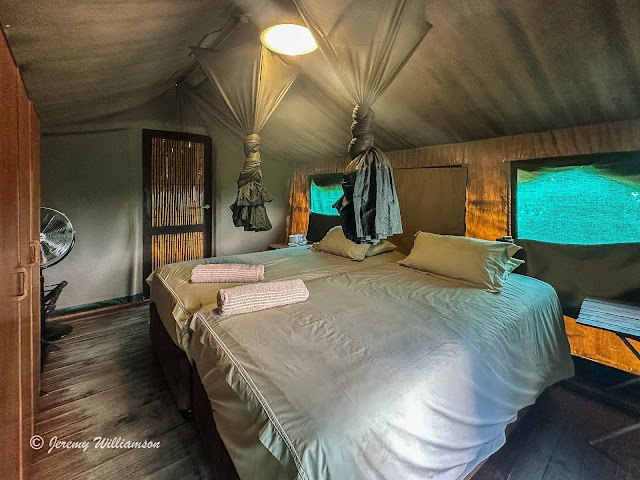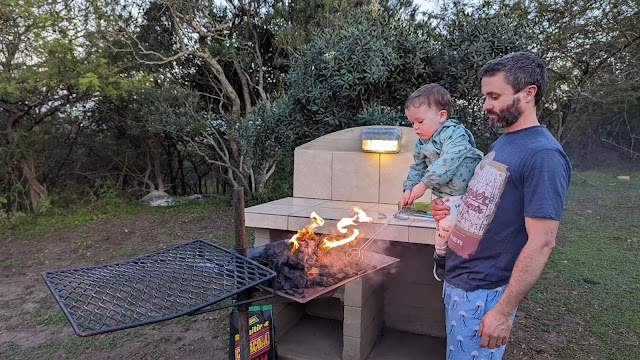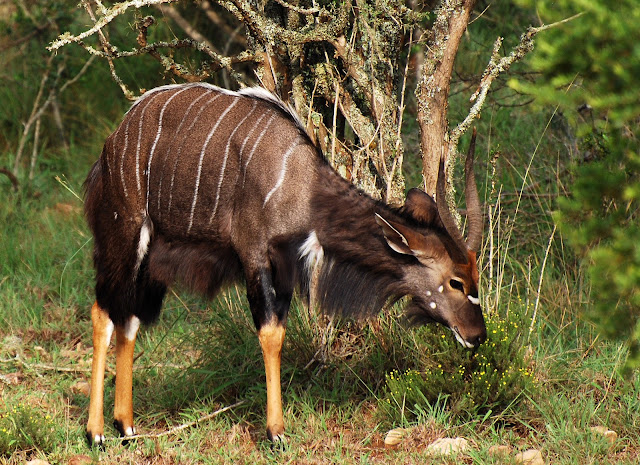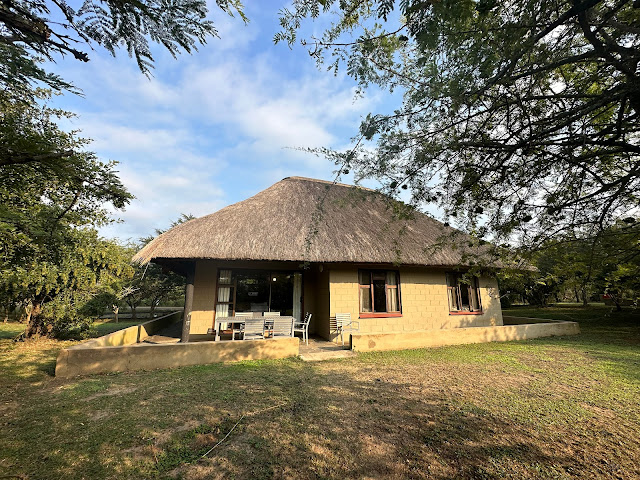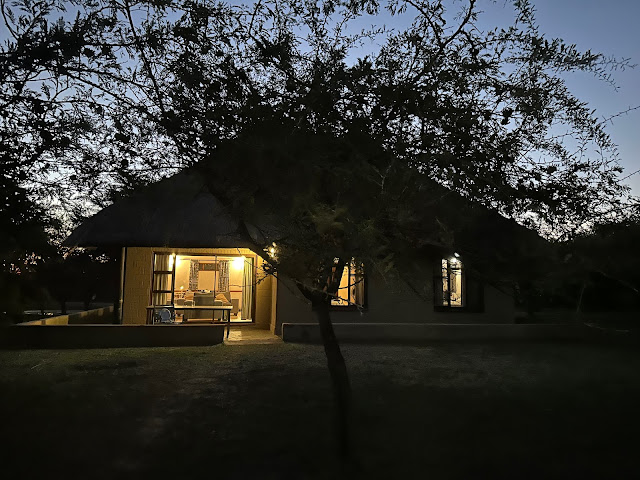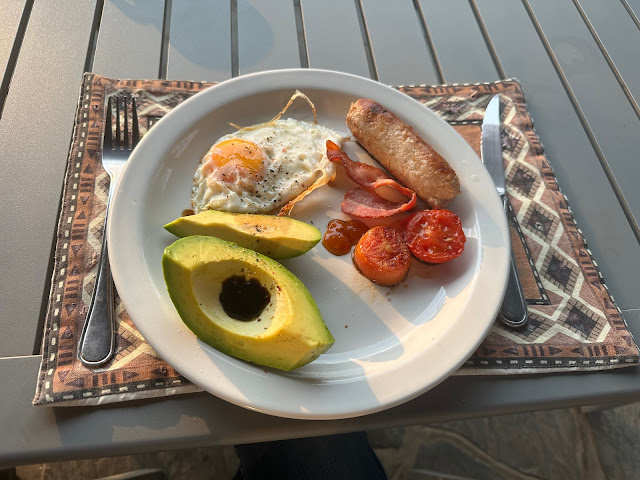After my not visiting the Hluhluwe iMfolozi Park for too long, I had the
perfect excuse, my daughter, her husband and their 2 year old, my Grandson,
were visiting us from the UK. Time for a little R and R in the bush. This youngster
needed an initiation into that which our family are so in touch, our Natural
environment and all that goes with it. The two elder parents needed a bit of
that therapy top-up too. Can you take a 22 month old child to the Game Reserve and enjoy the experience?
A similar thought must have been prominent in my parent's minds as they took us, at a very early age to various game parks throught South Africa. Here we are in Hluhulwe Game Reserve soon after Shorty had translocated there from the then Eastern Transvaal. The first of the Giraffe in the area.
Can you recognise a little Jeremy? Was blue really my colour?
Game guards would accompany each vehicle back then. Seems like dad was allowed out of his car back then, to take the photograph.
We decide
to pop into St Lucia Lake Estuary town for a bit of an update. One really needs
to spend a night or two here to make the most of its numerous facilities. The
town was buzzing with visitors! From cruises on the Estuary (about 2 hours
duration) loads of hippo and crocodile, to deep sea fishing / whale watching.
Then tours of the wildlife rich Eastern and western shores, with the Eastern
shores terminating at the delightful Cape Vidal beach, with its snorkelling and
tidal pools, fishing and Ski-boating. Some interesting wildlife here in the
coastal forests too, Somango Monkey, Red Duiker and the Red Thonga Squirrel
along with a host of birdlife, some other rarities too, the forests are home to
the most beautiful, our largest Adder, the very cryptically coloured Gaboon.
This has the longest fangs of any of our southern African snakes and is rather
venomous, be vigilant. Another fascinating excursion is with one of the local concession
holding Tour Operators, to go out on a nocturnal Turtle sightseeing tour on the
beaches of Thongaland. In my youth, I
was a member of a club based at Cape Vidal, and spent many an evening
witnessing these giant reptiles laboriously exiting the Indian Ocean, struggling
through the dunes, to dig their nests above the high water line, lay their eggs
and then abandon them to their fate. We have both the Loggerhead (the worlds largest
living turtle) and Leatherback Turtles nesting on these beaches with occasional
visitors of the Green, Hawksbill and Olive Ridley turtles foraging in the
shallow waters offshore. Thanks to the initiation by George Hughes and the then
Natal parks Board, in undergoing extensive research and consequently installing
the necessary protective measures so necessary for the protection of these vulnerable
bash nesters. On one occasion I was with one of the Parks Board research
officers, Warren van Schoor. He explained how so many of the females would lay
their new lot of eggs almost on their previous nest or certainly close to. This
accurately documents by these stalwarts of Conservation.


The town
has a rather interesting claim to fame, the nocturnal visits of hippo roaming
the town in search of the more tasty verge grasses? Another, a fair
concentration of leopard making their presence known, even in town, but more
frequently seen late afternoon on the roads of the Eastern shores, time for a
Sunset drive! Makes for exciting nocturnal enjoyment. Our stop was brief, so pleased
to see the smiling faces and loaded stalls from local vendors, I had to
purchase a bag of ‘Butter' Avocado Pears and a wire push along toy for my grandson. A further revictualling from the numerous supermarkets and the loads
of eateries and coffee houses. Cayden couldn’t resist Tannie’s Vleispastei and
promptly sat on the stoep to satiate his hunger. He ate the entire pie without even offering a bit to his dad.
The drum beatring wire push along - even the monkeys were enthralled
We were on
our way to the oldest proclaimed Game Reserve in South Africa with its vast
diversity of plant and animal life, the Hluhluwe Imfolozi Park.
Our
destination was Mpila Camp in the southern sector of the Hluhluwe iMfolozi Park,
had it been to Hilltop Camp in the north, the Hluhluwe Section, I would have
opted to divert through the Western shores of Lake St Lucia’s Isimangaliso
Wetland Park, this loaded with wildlife, and to exit at Charter’s Creek onto
the N2, closer to the Memorial Gate entrance into the Hluhluwe Game Reserve
sector, bypassing Mtubatuba and making the most of the rich diversity of the
area. Instead, the R618 it was, a district road which unfortunately bisects the
Hluhluwe Imfolozi Park, established when the Corridor was not part of the
reserves, now a permanent road to the rural towns to the west of the Game
Reserve.
The Nselweni entrance gate
Having
recently undergone some repair, it is in good condition. Entering the Nyalazi Gate we had a bit of
paperwork to fill in, with reference numbers and name, we needed to prove our
overnight stay was booked. Don’t forget this, important. For those with Wild
Cards, which would then cancel the Conservation levy of those persons nominated
on the card, you will need the printed receipt to verify its validity, there is
no ‘card swipe machine’ there.
The tar
road to Mpila Camp passes the well-placed comfort stop where guests are able to
get out and stretch their legs and alleviate the constraints of their confines
in the vehicle. Centenary Centre with its vast Curio shop, take-away and
toilets with an interpretation centre on the organisation’s Rhino and other
game capture, is worth popping into and the Take-away staff there can work wonders.
The Vulamehlo Craft Centre at the Centenary Centre
A few
kilometers on, I had arranged to have a look at the delightful Masinda Lodge
again. This is a 3 bedroomed house with all en suite with full bathrooms, large
entertainment, dining, living and veranda areas with an extended kitchen where
a resident caretaker can assist with meal preparation. In addition there is a 2
bed annex with a lounging area and own bathroom, only a bath here. From the
veranda there is a braai and fire pit, safely distanced from the vulnerable
thatch. All these with expansice private views towards the distant Umfolozi
river and the bushveld with its intermittent ‘passing parade’.
I found all
the staff, from those at the entrance gates, in reception, shop and household
staff, all particularly friendly and helpful. I chose our overnight accommodation
to be at Mpila Camp, a 5 bed chalet, which was in pretty good general
condition. All utilities worked, although I must admit we did not try the TV.
Being a ‘high season’ weekend, be sure to book well in advance.
The tented camp has 2 and 4 sleeper selfcatering Safari tents too.
The shops
in the Park only carry the bare necessities, with bottled water, cool drinks
and charcoal available when we were there. Some other items too, but rather
take all your own supplies. I take a
backup lamp and always a sharp knife despite the chalets being well supplied
with all necessary basic cutlery and crockery.

There’s
something unique about game reserve accommodation, the smell of thatched
ceilings, polished floors and the anticipation of a glorious sunset around the
braai. Braais in the UK (well anywhere actually, and even at home), are
definitely not the same. The Bush without a Braai is like.... Jayson (son in law) was in his element, he and his
family, masters at the coalface, knowing just how and when to add the dinner
delights. He soon had the kindling up and on its way, as we sipped on our various
nectars of choice, relaxing, settling into the ambience of our Zululand bush,
dodging the swirling smoke, as it chose to target each in turn. Cayden, my
grandson, was not phased, I guess used to the odd winter barbecue surrounded by
snow, clothed in layers from the Icelandic chill. Here in Zululand, down to his
T-shirt and running shorts, he easily tolerating the whiff of a bit of renegade
wattle escaped from Australia, being rendered to ashes whilst watching the parade of antelope, warthog and monkeys in the grounds at Mpila camp..


Was that
hyena calling, as they exited their den to start their nocturnal foray of
hunting and scavenging? We were careful to be attentive of our cherished pieces
of meat which were being burned on the coals, they are known to purloin morsels
from the hot braai grid. No, instead, it
was family getting in first, burning their beaks on boerewors portions, broken
off from that serpentine coil Jay was mis-manhandling due to all the
interference, from what should have been calm spectators to his wizardry.
Anyway, the wors was for starters – being avaricious, cost the gang my creamy hot
English mustard and wasabi mix. Never mind. The coals started to get that white
crust - ready. With a flourish, the main dish for the dinner arrived in its
roasting receptacle, where it had enjoyed an addition of herbs, spices and that mix of sauces, and
handed over to our ‘Three hat Dunlop star chef’. Our mysterious kitchen claimant had
prepared the rest. Parboiled potatoes wrapped in foil, corn on the cob, also
subjected to the enclosure. Despite being South African, we, as a family enjoy an
array of vegetables along with the traditional ‘vleis, wors en pap’.
There was
smoke, there were flames, there were tears - done, the meat was returned to the
dish and the safety of the chalet to rest and let the juices infuse. We took
repose at the braai to rest and replenish, and let the juices infuse, Then, too
soon, it was ‘Dinner she is served’. With
a flurry, the tenderloin carved, spilling its secret stuffing and a bit of resident
moisture, as the ropes tethering the flesh were cut as the roll was sliced. Served
and dining alfresco on the veranda, repleat, even Cayden tucking into yet
another braai. What joy, an entire day's anticipation for our second evening's cookaton, this time a Prime Rib aka Tomohawk. Jay got this one cooked perfectly to a T. 'Ell that was good.
The embers
of the braai, safely some 30 meters from our chalet and its vulnerable thatch,
beckoned.
The coals being rejuvenated by Jay with a supply of timber for after
dinner pyrotechnics. Would it be an Amarula rather than the noble warming Port,
so necessary in the colder climes from whence they hail. Seated around this
column of smoke, flames and joy, to be honoured with a sighting of a rather precocious
porker, the Wild Pig have seemed to have replaced the hyena as nocturnal
scavengers at Mpila Camp.
The South
African way with hospitality is a given, and so enjoyed by travellers and
returning SAFFERS, but hey, we’re in da bush. As that eastern horizon hinted at
a change of colour, our brave band started to rise and congregate. With Gate
opening time at 06h00 there was time to fire up for a round or two of coffee
and Jay’s mother’s special rusks. Delish Margie!
Seated out on the stoep, from
where we could see the numerous herbivores, which had ventured to their deemed
safe haven (close to man!) for the night, slowly starting to disperse, we
enjoyed the cool gentle breeze, the dawning, the chorus of avifauna rising to a fair crescendo,
as the orchestra changed tune from the nocturnal hooting of an owl, the call of
a nightjar, the cackling and whooping of hyena and distant resonances of that
mighty roar reverberating over the airwaves in rhythmical grunts, rising to
quite a resounding cacophony. Panthera leo, we were not disappointed. See you
next time.
Ever
vigilant of the cunning Vervet monkeys, so opportunistic in escaping with one’s
‘padkos ‘, we loaded our vehicle with the snacks, refreshments, cameras and
binoculars. Taking a leaf out of the monkey’s book’, so we too posted a ‘guard’
at the car, to ensure our victuals would be safe for our early morning game
drive.

It was not
only little Cayden that was excited, as the Land Rover steered towards the
Umfolozi Basin and the host of wildlife there, the anticipation was rife, for
Lana and I, Jay and Lee too, all with a great deal of time spent in our
outdoors, it had been too long. What will it be, that first one out there in
the wilds? Slowly we engaged with an assortment of what the Hluhluwe Imfolozi
Park is famous for. We had time to crawl
along slowly, this really does afford some sightings one could so easily miss. As
expected, the vegetation throughout the Park was particularly dense, helped so
by the recent abundance of precipitation. So many of the waterholes were available
as drinking venues for the game, which consequently spread out to areas away
from their normal winter water supply, where they would be able to savour the
succulent and abundant vegetation, hardly grazed and browsed upon until summer,
these found away from the rivers and permanent water points, where they were
forced to imbibe in winter, when needing to be close to water. We searched Far and Wild and found a fair
abundance of game.
We came across one with a flock of White-faced Whisteling Duck and their young.

Some Impala with their 6 month old youmg
Lana managed to capture an image of a White-fronted Bee-eater.
Back for a
brunch of – what else? Bacon, eggs, sausage, tomato and Avo Oh, and that pot of the best smelling
beverage out. Lana's reduced portion.
Whilst the
family were keen on enjoying the resident wildlife within the camp, there was
just so much going on there, from the Vervet monkeys entertaining and showing
off to Cayden, the Warthog in somnolent repose, the Nyala coming for a drink,
the males testing one another, strutting stiff legged, manes erect and heads
posturing as they circle one another with their broadside lateral display, each
attempting to be larger than its opponent, then to a mud wallow to gouge their
horns and scent mark. The accumulated mud and debris on his forehead and horns bringing
attention to his virile status.
All this with a profusion of avifauna doing
their survival tricks too. Lana and I decided to pop down to a favourite camp
of ours, the Nselweni Bush Lodge, to see how it and the access road had fared
after the recent rains.
We found
the camp to be in a generally fair condition with the access road even having
had a bit of TLC, particularly where it gets washed and rutted a bit with heavy
rain in one steep section. The drains off the road were also newly graded. Well
done KZN Wildlife.
The
Ezemvelo KZN Wildlife organisation has, over the years, had its budget cut drastically,
which has adversely affected general maintenance. The ravages of Covid
certainly did not help either, consequently all their camps are in various states
of repair stress, with many general maintenance issues slowly being attended to
as funds allow. If you require all to be in 100% working order and condition,
possibly let us confer on alternative accommodation options. Despite what some
folk think, the accommodation in their Parks is still good value, in such a
special place nogal.
Probably
the most important issue for guests, is to rather bring in all your own
supplies, including drinking water. There is certainly no tangible stock of general
food items. There was water and charcoal at both Mpila and Hilltop camp shops,
but this could run out. Liquor is no longer available, so bring your own. There
is no corkage charged at the Hilltop Camp restaurant. Note that Mpila Camp,
Nselweni, Gqoyeni and Hlatikulu Bush Lodges are all on generator power with
varying on off times. Normally off at 22h00 and on again early mornings, so in
summer, no fans during those night time hours. Worth bringing a torch or lamp.
Charge all cameras, lamps, mobile phones timeously. Hilltop Camp is on Eskom
power with some generator backup. I could not
get over the enthusiasm of a soon to be 2-year-old, on how he so appreciated the animals, he quickly had all
regular one’s names down pat. Even telling us what that large grey behemoth
with massive ears, tusk and trunk should be known as. The Hluhluwe Imfolozi
Park certainly is a welcoming haven for families, us oldies too. We were
fortunate to have some large animal fairly close to our vehicle, I don’t think
that until then, Cayden quite appreciated the enormity of some of our large
animals. He has it all now though with Giraffe towering taller than their
London home??




Probably
the most popular picnic braai stop in the Umfolozi sector of the Park is that
on the Sontuli Loop. Toilets, braais, tables and chairs with an outlook over
the Black Umfolozi River, a favourite, with sincere thanks to the Umfolozi Honorary
Officer Corps for their generous maintenance thereof. For many years I was part
of that noble gang, being Chairman of the Hluhluwe Group, before becoming the
Regional Co-ordinator of all the Honorary Officer Corps of the KZN Wildlife
Game Reserves in Zululand, with all the Park Honorary Officer Groups constantly
visited or kept in touch with. A very rewarding time.
Despite
some rather torrential downpours in the area, the general condition of the
gravel roads that we traversed was good, with a few washed and rutted sections
across the roads. These easily negotiated by pretty well any normal car with
care. The very low-slung cars should rather keep to the tar roads.
I started
visiting the Hluhluwe and the Umfolozi Game Reserves at a very early age, was
it just after they were proclaimed? Certainly before the Corridor became part
of the integral Game Reserve. With literally more than 100 visits to the parks,
it is still a matter of luck having unusual / good sightings to a large extent.
I have no special formula, other than to be out early and return as late as
possible in the afternoon, with siesta over mid-day. I have only ever seen four
leopard properly in this complex. Now one of those that I saw, walked across
the road behind a car that I was following at a reasonable distance, and there
paraded in front of my car and gawking occupants, to the total oblivion of the
preceding, receding car. Had they only looked in their rear-view mirror. Luck?
An aid to guest are ‘sightings boards’ at various camps where guests indicate
where target species have been seen. Good to locate animals that are fixed to a
spot such as on a kill.
Jay. Lee
and Cayden had limited time on this visit ‘home’, with only 2 nights allocated
out of their meagre few to the Hluhluwe iMfolozi Park. Despite this, I see images
of elephant herds striding through the bush or wallowing in the plentiful waterholes, zebra not giving way on the roads,
impala doing their thing,

nyala, kudu, warthog, rhino, giraffe, all coming up
in a kaleidoscope in his mind given the right stimulus.

There was tortoise,
terrapin and so many birds. A reasonable gathering of White backed Vultures
too. Then his affinity with the primates
with whom he would have loved to engage more but mum wisely took care of his enthusiasm
and deferred his ambition to pet the odd monkey or baboon. Maybe photographs of
his holiday will do it. He has a collection of African animal toys at home that
will conjure up memories of Africa. We’ll look for the lion and cheetah on the
next visit. Maybe even Wild dog! Yip this reserve can and does produce the most
amazing game viewing, rather spend a couple of nights more though, to make the
most of this wonderful part of Zululand.



